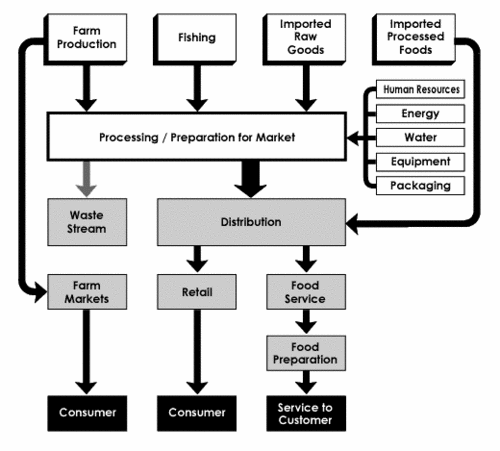Course:FNH200/Lessons/Lesson 01/Page 01.3
01.3 Extent of Canada's Food System
In Canada, we have a diverse food system with thousands of food products available for purchase. Those products include foods produced in Canada as well as food products imported from many countries around the world.
The Canadian food system is depicted in Figure 1.1. Foodstuffs (fruit, vegetables, cereal grains, oilseeds, animals, fowl) are produced by farmers involved in primary agricultural production. Fin fish, molluscs and crustaceans are harvested from the wild or raised on fish farms. Unprocessed foodstuffs and fish are also imported for sale or processing in Canada. These products are shipped directly to farmers' markets, processors or distributors. Many agricultural and fishery products undergo some form of processing/preservation prior to distribution to the consumer market. Many foods are fabricated from the foodstuffs produced by primary agricultural and fishery harvesting. Examples of fabricated foods are bread, smoked and cured luncheon meats, soft drinks, yogurt and chewing gum, to name a few.
Food products from processors or primary producers often pass through various distributors before they reach retail stores or food service outlets. Foods are retailed through chain stores and smaller independent stores, as well as numerous convenience stores which may be part of a chain or may be owned by an independent operator, as well as food co-operatives.
- Vegetables are sold in the fresh market as well as being processed (canned, frozen, dehydrted, fermented) to increase storage life.
- Greenhouse production of vegetables is an increasingly important component of the fresh market supply (cucumbers, peppers, lettuce, tomatoes) particularly in the fall and winter seasons.
- Seafood products are harvested and processed primarily in Atlantic Canada and in British Columbia. Seafood production includes the harvesting of wild stocks as well as production of salmon, oysters, clams and lobsters, under intensive production systems ('farmed' seafood). Cultivation of fish (trout) in fresh water occurs in a number of regions of Canada.
- Some products are transferred to the consumer market with a minimum of processing (e.g., fresh fruits, fresh vegetables) while others (e.g., beef, pork, poultry, milk, wheat) go through more extensive processing before being transported to the retail market. Many agricultural products (e.g., wheat flour, corn flour, corn starch, corn syrup, fruits, vegetables, milk, and milk components) become sources of ingredients for the production of other food products.
Below are the major Provinces in Canada involved in the production of different agricultural food commodities:
| Food commodity production | Province |
|---|---|
| Animal (beef, pork, poultry) | Widespread around Canada |
| Dairy milk production | Across Canada, Ontario, Quebec |
| Cereal grains | Alberta, Saskatchewan, Manitoba |
| Tree fruit; small fruits; cranberries, blueberries, raspberries | British Columbia; Ontario, Nova Scotia; Almost every province; British Columbia |
| Vegetables | All across Canada |
| Seafood | Atlantic Canada and British Columbia |
Many agricultural commodities, finished food products and ingredients are imported into Canada as well. These imported products must meet the same standards and regulatory requirements as foods produced in Canada. This aspect is discussed in more detail in the section of the course dealing with regulatory issues and standards (Lesson 4).
| Want to learn more? |
| How does this image from a trading store (ca. 1910) compare to the typical grocery store (supermarket) of today?
- Food production and marketing have come a long way since the 1900s |
